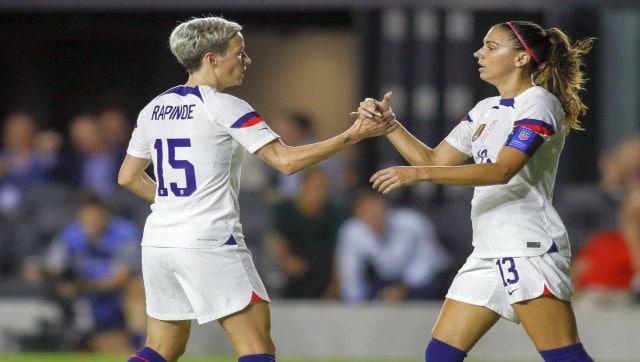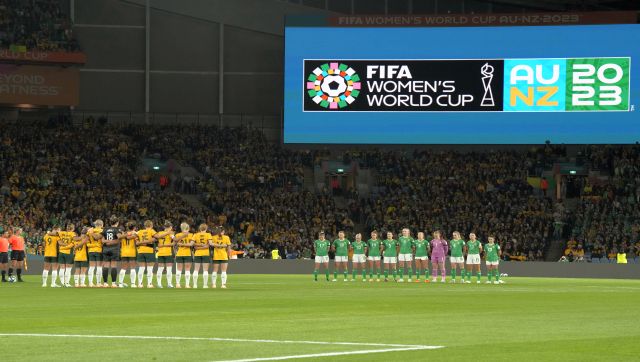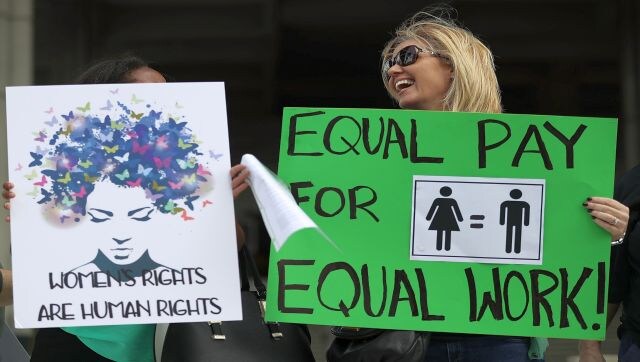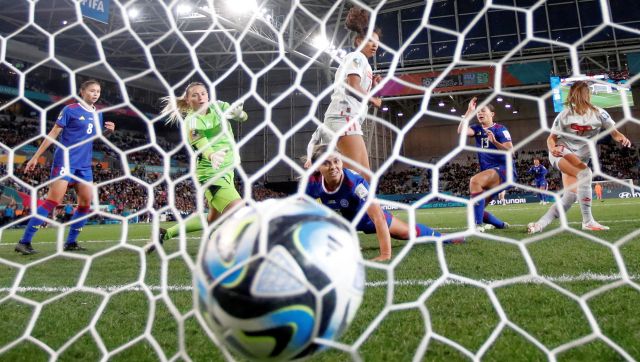One of the biggest sporting events kicked off on Thursday and with it focus has once again shifted to the important issue of pay parity. What are we talking about? It’s all about the
FIFA 2023 Women’s World Cup
and just how much do female athletes get paid vis-à-vis their male counterparts. Just before the opening match – New Zealand vs Norway – took place at Eden Park in Auckland, Women’s World Cup CEO David Beeche said: “This women’s tournament is not just about football. It’s about celebrating women’s sports and women’s empowerment all over the world.” As the tournament kicks off, it runs until 20 August, we take a closer look at just how much women footballers are paid and the issue of pay parity in sports and in the open world. What do women footballers earn? This Women’s World Cup, the athletes on average will earn just 25 cents for every dollar earned by men at their World Cup last year, a CNN analysis revealed. This, however, is a step up for the women. In 2019, the last time the event took place, the women earned less than eight cents per dollar, according to data provided by world governing body FIFA and global players’ union Fédération Internationale des Associations de Footballeurs Professionnels (FIFPRO). In fact, before the tournament began, FIFA announced that about $49 million (Rs 402 crore) of the record $110 million (Rs 900 crore) Women’s World Cup prize money would go directly to individual players — at least $30,000 (Rs 24 lakh) each for participating and $270,000 (Rs 2.21 crore) to each player on the winning squad. [caption id=“attachment_12897492” align=“alignnone” width=“640”] Graphic: Pranay Bhardwaj[/caption] The players’ union praised the move as the “outcome of tremendous global collective action by over 150 national team players”. FIFA President Gianni Infantino has also set a target of equal prize money for men and women at their next World Cups, in 2026 and 2027, respectively. This struggle for pay parity has been long and tedious. In fact, in 1991 and 1999, the women’s game had zero prize money. The struggle for pay parity is not just at the World Cup level. The United States, four-time champions, agreed just last year to a deal that includes equal pay and a plan to share World Cup prize money — evening out the disparity between the men’s and women’s tournaments. [caption id=“attachment_12897512” align=“alignnone” width=“640”]
Graphic: Pranay Bhardwaj[/caption] The players’ union praised the move as the “outcome of tremendous global collective action by over 150 national team players”. FIFA President Gianni Infantino has also set a target of equal prize money for men and women at their next World Cups, in 2026 and 2027, respectively. This struggle for pay parity has been long and tedious. In fact, in 1991 and 1999, the women’s game had zero prize money. The struggle for pay parity is not just at the World Cup level. The United States, four-time champions, agreed just last year to a deal that includes equal pay and a plan to share World Cup prize money — evening out the disparity between the men’s and women’s tournaments. [caption id=“attachment_12897512” align=“alignnone” width=“640”] The pay gap in football is real. Sample this: America’s Megan Rapinoe (left) and Alex Morgan were the highest paid female football players last year, earning $5.7 million each on and off the pitch. On the other hand, their most successful male counterpart, Cristiano Ronaldo, earned $136 million from both on-field and off-field revenue, Forbes estimated. File image/Reuters[/caption] Norway, Australia and the Netherlands are some of the countries that have taken steps to close the pay gap. England’s Football Association said that their men and women’s teams are being paid the same appearance fee to represent their country. Other teams like Canada, South Africa continue to struggle with a pay dispute. In fact, the South African team, nicknamed Banyana Banyana, boycotted a warm-up match because of the lack of bonuses offered by the South African Football Association (SAFA) and no written agreements about World Cup payments. But despite the poor pay, women’s football is enjoying a surge in popularity. FIFA’s chief women’s football officer, Sarai Bareman, told NewsCorp Australia that more than two billion viewers were expected to tune in to watch the event, double the previous tournament in France. And Bareman believes that this tournament could be the “watershed moment that changed everything and took the game to the next level”. [caption id=“attachment_12897532” align=“alignnone” width=“640”]
The pay gap in football is real. Sample this: America’s Megan Rapinoe (left) and Alex Morgan were the highest paid female football players last year, earning $5.7 million each on and off the pitch. On the other hand, their most successful male counterpart, Cristiano Ronaldo, earned $136 million from both on-field and off-field revenue, Forbes estimated. File image/Reuters[/caption] Norway, Australia and the Netherlands are some of the countries that have taken steps to close the pay gap. England’s Football Association said that their men and women’s teams are being paid the same appearance fee to represent their country. Other teams like Canada, South Africa continue to struggle with a pay dispute. In fact, the South African team, nicknamed Banyana Banyana, boycotted a warm-up match because of the lack of bonuses offered by the South African Football Association (SAFA) and no written agreements about World Cup payments. But despite the poor pay, women’s football is enjoying a surge in popularity. FIFA’s chief women’s football officer, Sarai Bareman, told NewsCorp Australia that more than two billion viewers were expected to tune in to watch the event, double the previous tournament in France. And Bareman believes that this tournament could be the “watershed moment that changed everything and took the game to the next level”. [caption id=“attachment_12897532” align=“alignnone” width=“640”] Australia, left, and Ireland players stand before their first match at the World Cup. This year, there are expectations that more than two billion viewers will tune in to watch the event, double the previous tournament in France. Reuters[/caption] What about other sports? The issue of pay parity is not just restricted to women’s football. Other sports too see a pay gap and have been fighting against it. Just recently, as of 13 July, the International Cricket Council (ICC) announced
equal prize money for men’s and women’s teams
at its global events in a bid to bring in pay parity. ICC Chair Greg Barclay was quoted as saying: “This is a significant moment in the history of our sport, and I am delighted that men’s and women’s cricketers competing at ICC global events will now be rewarded equally. “Since 2017 we have increased prize money at women’s events every year with a clear focus on reaching equal prize money and from here on in, winning the ICC Women’s Cricket World Cup will carry the same prize money as winning the ICC Men’s Cricket World Cup and the same for T20 World Cups and U19s too.” [caption id=“attachment_12897582” align=“alignnone” width=“640”]
Australia, left, and Ireland players stand before their first match at the World Cup. This year, there are expectations that more than two billion viewers will tune in to watch the event, double the previous tournament in France. Reuters[/caption] What about other sports? The issue of pay parity is not just restricted to women’s football. Other sports too see a pay gap and have been fighting against it. Just recently, as of 13 July, the International Cricket Council (ICC) announced
equal prize money for men’s and women’s teams
at its global events in a bid to bring in pay parity. ICC Chair Greg Barclay was quoted as saying: “This is a significant moment in the history of our sport, and I am delighted that men’s and women’s cricketers competing at ICC global events will now be rewarded equally. “Since 2017 we have increased prize money at women’s events every year with a clear focus on reaching equal prize money and from here on in, winning the ICC Women’s Cricket World Cup will carry the same prize money as winning the ICC Men’s Cricket World Cup and the same for T20 World Cups and U19s too.” [caption id=“attachment_12897582” align=“alignnone” width=“640”] On 13 July, the ICC announced equal prize money for men’s and women’s teams at its global events. PTI[/caption] The Grand Slam events in
Tennis
– the Australian Open, the French Open, Wimbledon and the US Open – follow the equal play doctrine but not the other championships. Golf is another sport where pay parity is glaring. However, the situation is slowly improving with a BBC research in 2017 showing that 83 per cent of sports now reward men and women equally. This change is coming about as perceptions on sport itself are changing. It is no longer seen as a men’s arena. Big brands and sponsorship deals are going the women’s way, making it a more profitable option. A 2022 study by the US-based National Research Group has revealed that 30 per cent of sports fans are watching more women’s sports than they used to over the past five years, while 25 per cent are watching more over the past year. But there are still some who argue that men deserve more pay in sports owing to the competitive field. They argue that men are stronger, faster and hence, should be paid more. But this argument is that of comparing apples with oranges. At the end of the day, women’s sports are not less physical; female football plays are still running at top speeds like men to score goals, female boxers are still belting each other with the same kind of punches as men do and female rugby players continue to break their noses just as their male counterparts do. What about off the field? And pay parity is not an issue restricted only to sports. Women across the world and across different professions continue to get paid less than the men. Women’s work is on a daily basis under-recognised and undervalued across every sector and every area of life, perpetuating the global gender inequality crisis. In fact, women globally are paid about 20 per cent less than men, according to the International Labour Organization (ILO); in health care, women earn 24 per cent less than men; women in agriculture earn on average 82 cents for every dollar that men earn. The United Nations in a recent report stated gender equality is “300 years away”. [caption id=“attachment_12897702” align=“alignnone” width=“640”]
On 13 July, the ICC announced equal prize money for men’s and women’s teams at its global events. PTI[/caption] The Grand Slam events in
Tennis
– the Australian Open, the French Open, Wimbledon and the US Open – follow the equal play doctrine but not the other championships. Golf is another sport where pay parity is glaring. However, the situation is slowly improving with a BBC research in 2017 showing that 83 per cent of sports now reward men and women equally. This change is coming about as perceptions on sport itself are changing. It is no longer seen as a men’s arena. Big brands and sponsorship deals are going the women’s way, making it a more profitable option. A 2022 study by the US-based National Research Group has revealed that 30 per cent of sports fans are watching more women’s sports than they used to over the past five years, while 25 per cent are watching more over the past year. But there are still some who argue that men deserve more pay in sports owing to the competitive field. They argue that men are stronger, faster and hence, should be paid more. But this argument is that of comparing apples with oranges. At the end of the day, women’s sports are not less physical; female football plays are still running at top speeds like men to score goals, female boxers are still belting each other with the same kind of punches as men do and female rugby players continue to break their noses just as their male counterparts do. What about off the field? And pay parity is not an issue restricted only to sports. Women across the world and across different professions continue to get paid less than the men. Women’s work is on a daily basis under-recognised and undervalued across every sector and every area of life, perpetuating the global gender inequality crisis. In fact, women globally are paid about 20 per cent less than men, according to the International Labour Organization (ILO); in health care, women earn 24 per cent less than men; women in agriculture earn on average 82 cents for every dollar that men earn. The United Nations in a recent report stated gender equality is “300 years away”. [caption id=“attachment_12897702” align=“alignnone” width=“640”] Protesters demand equal pay as their male co-workers in Fort Lauderdale, Florida. File image/AFP[/caption] But all is not doom and gloom. In an attempt to bridge the pay gap, several countries are introducing legislation on the matter. In March,
Australia
passed a law that requires firms with more than 100 employees to reveal their gender pay gaps from early next year. Also read: How perfect are the world’s most gender-equal countries? Where does India stand?
Other countries are also doing their bit; Iceland, in 2018, was the first country in the world to legalise equal pay. A new law made it illegal to pay men more than women. Britain made it mandatory in 2017 for all companies with more than 250 employees to report the difference in earnings between male and female staff. The European Union and Japan also have similar legislation. Spain also introduced legislation to bridge the gap between payments made to men and women. As for now, all eyes will turn to the FIFA Women’s World Cup where the goal will be equality. With inputs from agencies
Protesters demand equal pay as their male co-workers in Fort Lauderdale, Florida. File image/AFP[/caption] But all is not doom and gloom. In an attempt to bridge the pay gap, several countries are introducing legislation on the matter. In March,
Australia
passed a law that requires firms with more than 100 employees to reveal their gender pay gaps from early next year. Also read: How perfect are the world’s most gender-equal countries? Where does India stand?
Other countries are also doing their bit; Iceland, in 2018, was the first country in the world to legalise equal pay. A new law made it illegal to pay men more than women. Britain made it mandatory in 2017 for all companies with more than 250 employees to report the difference in earnings between male and female staff. The European Union and Japan also have similar legislation. Spain also introduced legislation to bridge the gap between payments made to men and women. As for now, all eyes will turn to the FIFA Women’s World Cup where the goal will be equality. With inputs from agencies
How Women’s World Cup is kicking off the debate on pay parity
FP Explainers
• July 21, 2023, 16:37:20 IST
The FIFA Women’s World Cup 2023 has started in style. This edition will see the female footballers earning 25 cents for every dollar that their male counterparts earned last year. While this is an improvement from the past, women have a long way to go on and off the field in the matter of pay parity
Advertisement
)
End of Article